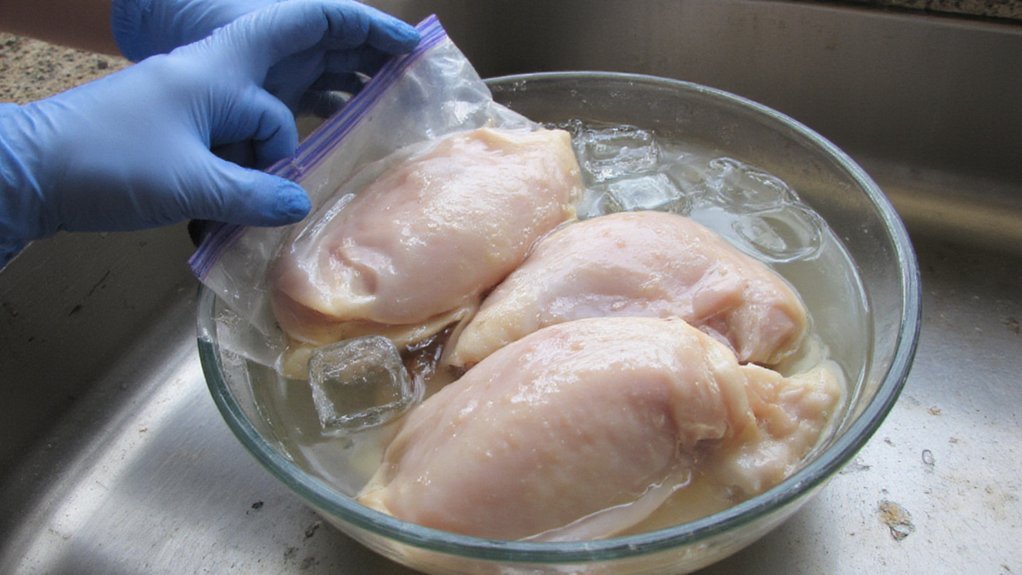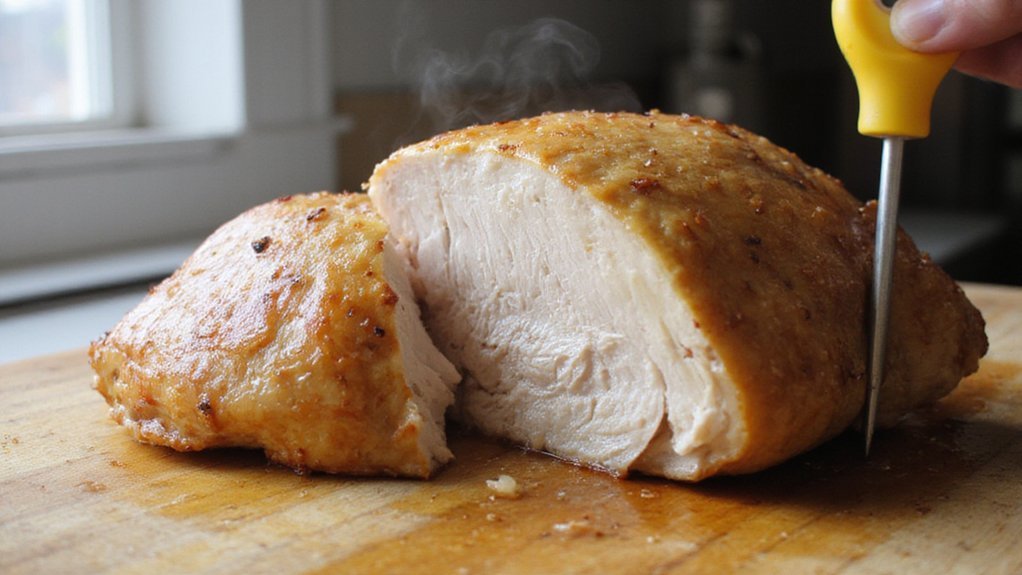When you’re short on time, you still need to thaw chicken safely to avoid bacterial growth. The refrigerator method is slowest but safest; cold-water and microwave methods are faster when done correctly and when you cook immediately afterward. I’ll outline exact thawing times, packaging and handling tips, and the final temperature targets so you can pick the right approach for your schedule.
Key Takeaways
- Refrigerator thawing is safest: keep refrigerator ≤40°F and allow about 24 hours per 4–5 lb whole chicken, smaller pieces overnight.
- Cold-water thaw: submerge in sealed packaging, change water every 30 minutes; small pieces <1 hour, larger cuts 1–3 hours.
- Microwave defrost: use the microwave’s defrost setting, stop if edges begin to cook, and cook immediately after thawing.
- Prevent cross-contamination by keeping chicken in leak-proof packaging, using separate tools, and sanitizing surfaces after contact.
- Always cook chicken to an internal temperature of 165°F (74°C) in the thickest part with an instant-read thermometer.
Why Thawing Properly Matters
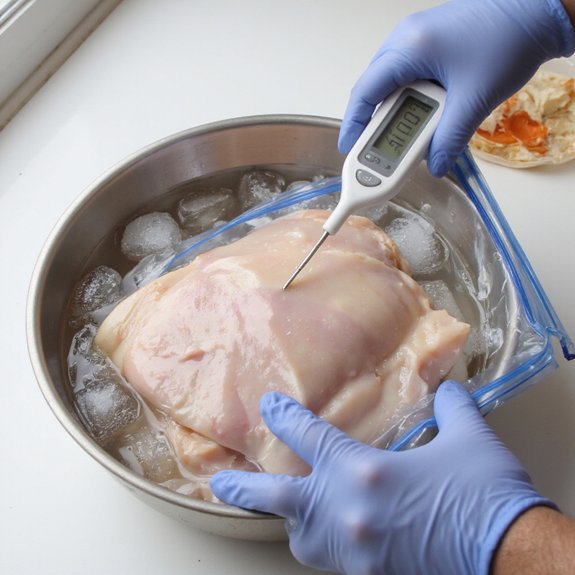
Because frozen chicken spends time in the temperature “danger zone,” thawing it improperly lets bacteria such as Salmonella and Campylobacter multiply rapidly; you’ll increase your risk of foodborne illness if you don’t control temperature. You should prioritize controlled, documented methods that minimize time between frozen and cooking. Rapid-thaw options—cold-water submersion in sealed packaging with water changes every 30 minutes, or microwave defrosting followed by immediate cooking—reduce bacterial growth when applied correctly. Use an instant-read thermometer to confirm core temperatures before cooking starts, and discard chicken if it’s been over two hours above 40°F (4°C). Implement simple process checks: sealed packaging, timed intervals, and temperature logs. That approach lowers health risks and supports consistent food safety outcomes, while letting you iterate on workflows or tech aids like smart timers and connected thermometers. Adopt these practices to innovate safely and keep risk predictable. Track results and adjust protocols regularly, always.
Thawing in the Refrigerator: Slow and Safe
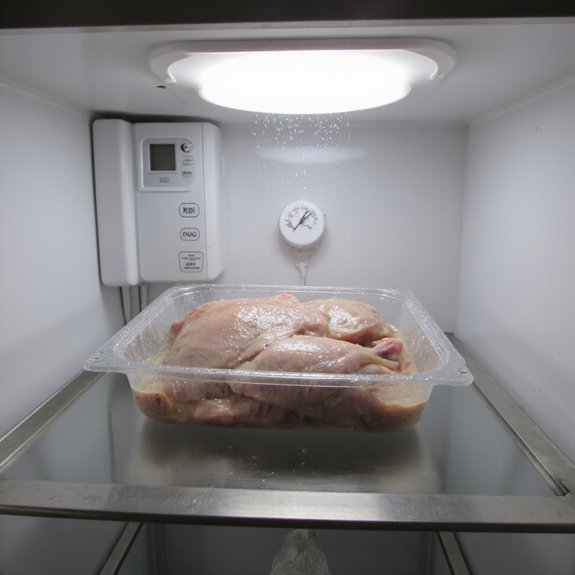
Refrigerator thawing is the safest, most controlled method: keep the fridge at 40°F (4°C) or below, leave the chicken in its airtight packaging or sealed container on the bottom shelf to catch drips, and plan roughly 24 hours of thaw time for every 4–5 pounds of whole bird (smaller pieces usually thaw overnight). You’ll rely on consistent refrigerator temperature to suppress bacterial growth while you manage workflow and menu timing. For precision, measure fridge temp with a probe thermometer and log it; small innovations like an app-connected sensor help you monitor remotely. Estimate thawing duration based on weight, spacing, and packaging—dense packing prolongs time. Once thawed, use whole birds within 1–2 days and pieces within 24 hours; don’t refreeze raw chicken that’s been fully thawed unless you cook it first. This approach is evidence-based, low-risk, and practical for kitchens that value predictable, scalable food-safety systems. Trust measured processes.
Quick Thawing Methods: Cold Water and Microwave
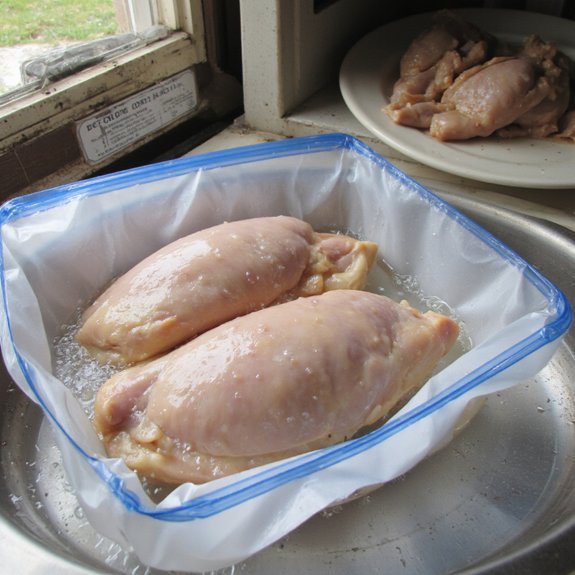
If you need to speed thawing, two safe, fast options are the cold‑water method and microwave defrosting—each with clear steps and limits. For cold‑water, submerge the chicken in cold water and change the water every 30 minutes; expect small pieces to thaw in under an hour and larger cuts in 1–3 hours. Maintain low temperature to limit bacterial growth. Use the microwave method to defrost when you intend to cook immediately: select defrost or low‑power cycles, rotate or flip as prompted, and monitor closely to prevent partial cooking. Both techniques trade time for immediacy—cold‑water preserves texture better, while microwave method is fastest but can create hot spots. After thawing, cook chicken promptly; do not refreeze raw chicken thawed by these quick methods unless cooked first. These approaches are supported by food safety guidance prioritizing temperature control and minimal time in the danger zone for reliable, efficient results consistently.
Handling, Packaging, and What to Avoid
When handling thawed chicken, keep raw meat separate and work quickly to minimize time in the danger zone (40–140°F/4–60°C).
| Risk | Control | Outcome |
|---|---|---|
| Blood on counter | Immediate wipe, sanitize | Unease → Relief |
| Touching other foods | Use gloves, separate tools | Anxiety → Confidence |
| Torn packaging | Replace with sealed bag | Vulnerability → Security |
| Slow thawing | Use fridge or cold water | Frustration → Assurance |
Use clean packaging materials and leak‑proof bags to contain juices, label dates, and avoid torn wraps. Prevent handling cross contamination by designating cutting boards, utensils, and a one-way workflow from raw to clean. Don’t rinse chicken — spreads bacteria. If surfaces or tools touch raw meat, wash them immediately with hot, soapy water and sanitize. Plan tasks so thawed chicken isn’t left on counters; move it straight to preparation or back to cold storage. Innovate with color-coded tools, smart containers, and quick‑swap liners to reduce risk handling.
Cooking, Timing, and Safe Temperature
Because proper cooking kills harmful bacteria, you should cook thawed chicken to an internal temperature of 165°F (74°C) measured in the thickest part (avoiding bone) and verify with a calibrated instant‑read thermometer; let larger pieces rest for a few minutes so carryover heat finishes the job and juices redistribute. Plan cooking times based on weight and cut—boneless breasts need about 12–18 minutes at 375°F, thighs and drumsticks 25–35 minutes—while using your thermometer rather than time alone. For safety tips, avoid partial cooking to finish later and never refreeze chicken thawed in warm water; refrigerate if you delay cooking. Use high-quality tools: calibrated thermometers, oven probes, or smart cookware that logs temperature curves for reproducibility and innovation in meal prep. If you roast whole birds, factor in 15–20 minutes of rest; check multiple points for consistent doneness. Record cooking times and temperatures to refine outcomes and reduce food-safety risk now.
